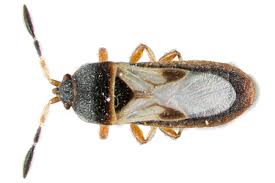This week, we’re zooming in on one of the sneakiest pests in Austin lawns: the dreaded chinch bug. If you’ve got St. Augustine grass (like many Central Texans), this one’s especially for you.
What Do Chinch Bugs Do?
Chinch bugs feed on grass by sucking out moisture and injecting toxins, leaving behind yellow patches that quickly turn brown and brittle. The damage looks a lot like heat stress or drought—but it’s not. And if you’re not watching closely, they can take out large sections of your lawn before you know it.
What Does Chinch Bug Damage Look Like?
- Irregular patches of yellowing or browning grass
- Damage often appears in full sun areas, not shade
- The surrounding grass may still look perfectly healthy
- Spots grow outward from the center as bugs spread

How do you identify Chinch Bugs?
They’re tiny, about 1/5 of an inch at full size, and often hard to spot without help.


Here are three ways to check:
- The Towel Test: Place a white towel or sheet of paper on the edge of a suspicious patch. Wait a few minutes. If chinch bugs are present, you’ll likely see small dark bugs crawling or hopping onto it.
- The Coffee Can Trick: Cut the bottom out of a coffee can (or soup can), push it into the soil, and fill with water. Within 5–10 minutes, chinch bugs will float to the top if they’re hiding below the surface.
- Ask a Pro: Our partners at Emerald Lawns handle these all the time and are great at confirming chinch bug activity. Snap a photo and send it to us, we’re happy to help identify if chinch bugs are your culprit.
What Can You Do About It?
Treatment usually requires a specialized insecticide, which you can find at lawn and garden centers. But for best results and fast action, we recommend a professional pest control application. Our annual program with Emerald Lawns includes treatments for chinch bugs, grub worms, and army worms this time of year.
Why This Matters Now
As Austin temps rise into the upper 90s and 100s, lawns are naturally under more stress. That makes them more vulnerable to pests like chinch bugs. Keep an eye on your yard and don’t assume every brown patch is just heat.
Other helpful sources:
- https://extensionentomology.tamu.edu/wp-content/uploads/2025/03/Chinch-bug-in-St-Augustine-lawn.pdf
- https://extensionentomology.tamu.edu/wp-content/uploads/2025/03/southern-chinch-bug-identification-and-control.pdf
Have questions or want to make sure your lawn is protected? Let’s talk.
— The Top Choice Lawn Care Team

